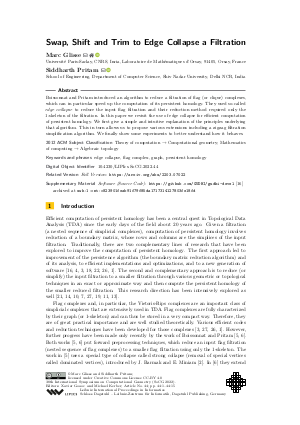Swap, Shift and Trim to Edge Collapse a Filtration
Authors
Marc Glisse  ,
Siddharth Pritam
,
Siddharth Pritam 
-
Part of:
Volume:
38th International Symposium on Computational Geometry (SoCG 2022)
Part of: Series: Leibniz International Proceedings in Informatics (LIPIcs)
Part of: Conference: Symposium on Computational Geometry (SoCG) - License:
 Creative Commons Attribution 4.0 International license
Creative Commons Attribution 4.0 International license
- Publication Date: 2022-06-01
File

PDF
LIPIcs.SoCG.2022.44.pdf
- Filesize: 1.09 MB
- 15 pages
Document Identifiers
Related Versions
- Full Version https://arxiv.org/abs/2203.07022
Subject Classification
ACM Subject Classification
- Theory of computation → Computational geometry
- Mathematics of computing → Algebraic topology
Keywords
- edge collapse
- flag complex
- graph
- persistent homology
Metrics
- Access Statistics
-
Total Accesses (updated on a weekly basis)
0Document
0Metadata
Abstract
Boissonnat and Pritam introduced an algorithm to reduce a filtration of flag (or clique) complexes, which can in particular speed up the computation of its persistent homology. They used so-called edge collapse to reduce the input flag filtration and their reduction method required only the 1-skeleton of the filtration. In this paper we revisit the use of edge collapse for efficient computation of persistent homology. We first give a simple and intuitive explanation of the principles underlying that algorithm. This in turn allows us to propose various extensions including a zigzag filtration simplification algorithm. We finally show some experiments to better understand how it behaves.
Cite As Get BibTex
Marc Glisse and Siddharth Pritam. Swap, Shift and Trim to Edge Collapse a Filtration. In 38th International Symposium on Computational Geometry (SoCG 2022). Leibniz International Proceedings in Informatics (LIPIcs), Volume 224, pp. 44:1-44:15, Schloss Dagstuhl – Leibniz-Zentrum für Informatik (2022)
https://doi.org/10.4230/LIPIcs.SoCG.2022.44
BibTex
@InProceedings{glisse_et_al:LIPIcs.SoCG.2022.44,
author = {Glisse, Marc and Pritam, Siddharth},
title = {{Swap, Shift and Trim to Edge Collapse a Filtration}},
booktitle = {38th International Symposium on Computational Geometry (SoCG 2022)},
pages = {44:1--44:15},
series = {Leibniz International Proceedings in Informatics (LIPIcs)},
ISBN = {978-3-95977-227-3},
ISSN = {1868-8969},
year = {2022},
volume = {224},
editor = {Goaoc, Xavier and Kerber, Michael},
publisher = {Schloss Dagstuhl -- Leibniz-Zentrum f{\"u}r Informatik},
address = {Dagstuhl, Germany},
URL = {https://drops.dagstuhl.de/entities/document/10.4230/LIPIcs.SoCG.2022.44},
URN = {urn:nbn:de:0030-drops-160525},
doi = {10.4230/LIPIcs.SoCG.2022.44},
annote = {Keywords: edge collapse, flag complex, graph, persistent homology}
}
Author Details
- Université Paris-Saclay, CNRS, Inria, Laboratoire de Mathématiques d'Orsay, 91405, Orsay, France
Supplementary Materials
-
Software (Source Code)
https://github.com/GUDHI/gudhi-devel
browse
 archived version
archived version
References
- M. Aggarwal and V. Periwal. Dory: Overcoming barriers to computing persistent homology, 2021. URL: http://arxiv.org/abs/2103.05608.
- J. A. Barmak and E. G. Minian. Strong homotopy types, nerves and collapses. Discrete and Computational Geometry, 47:301-328, 2012. URL: https://doi.org/10.1007/s00454-011-9357-5.
- U. Bauer. Ripser: efficient computation of Vietoris-Rips persistence barcodes. Journal of Applied and Computational Topology, 5(3):391-423, 2021. URL: https://doi.org/10.1007/s41468-021-00071-5.
- U. Bauer, M. Kerber, J. Reininghaus, and H. Wagner. PHAT - persistent homology algorithms toolbox. Journal of Symbolic Computation, 78, 2017. URL: https://doi.org/10.1016/j.jsc.2016.03.008.
- J-D. Boissonnat and S. Pritam. Computing persistent homology of flag complexes via strong collapses. International Symposium on Computational Geometry (SoCG), 2019. URL: https://doi.org/10.4230/LIPIcs.SoCG.2019.55.
- J-D. Boissonnat and S. Pritam. Edge collapse and persistence of flag complexes. International Symposium on Computational Geometry (SoCG), 2020. URL: https://doi.org/10.4230/LIPIcs.SoCG.2020.19.
- M. Botnan and G. Spreemann. Approximating persistent homology in Euclidean space through collapses. In: Applicable Algebra in Engineering, Communication and Computing, 26:73-101, 2015. URL: https://doi.org/10.1007/s00200-014-0247-y.
- G. Carlsson and V. de Silva. Zigzag persistence. Found Comput Math, 10, 2010. URL: https://doi.org/10.1007/s10208-010-9066-0.
- F. Chazal, V. de Silva, M. Glisse, and S. Oudot. The Structure and Stability of Persistence Modules. SpringerBriefs in Mathematics. Springer, Cham, 2016. URL: https://doi.org/10.1007/978-3-319-42545-0.
- F. Chazal and S. Oudot. Towards persistence-based reconstruction in Euclidean spaces. International Symposium on Computational Geometry (SoCG), 2008. URL: https://doi.org/10.1145/1377676.1377719.
- A. Choudhary, M. Kerber, and S. Raghvendra:. Polynomial-sized topological approximations using the permutahedron. Discrete and Computational Geometry, 61:42-80, 2019. URL: https://doi.org/10.1007/s00454-017-9951-2.
- H. Derksen and J. Weyman. Quiver representations. Notices of the American Mathematical Society, 52(2):200-206, February 2005. URL: https://www.ams.org/journals/notices/200502/fea-weyman.pdf.
- T. K. Dey, D. Shi, and Y. Wang. Simba: An efficient tool for approximating Rips-filtration persistence via simplicial batch collapse. ACM J. Exp. Algorithmics, 24, January 2019. URL: https://doi.org/10.1145/3284360.
- P. Dłotko and H. Wagner. Simplification of complexes for persistent homology computations. Homology, Homotopy and Applications, 16:49-63, 2014. URL: https://doi.org/10.4310/HHA.2014.v16.n1.a3.
-
H. Edelsbrunner and J. Harer. Computational Topology: An Introduction. American Mathematical Society, 2010.

- Gudhi: Geometry understanding in higher dimensions. URL: https://gudhi.inria.fr/.
- A. Hatcher. Algebraic Topology. Univ. Press Cambridge, 2001. URL: https://pi.math.cornell.edu/~hatcher/AT/ATpage.html.
- A. Hylton, G. Henselman-Petrusek, J. Sang, and R. Short. Tuning the performance of a computational persistent homology package. Software: practice & experience, 49(5):885-905, May 2019. URL: https://doi.org/10.1002/spe.2678.
- M. Kerber and R. Sharathkumar. Approximate Čech complex in low and high dimensions. In Algorithms and Computation, pages 666-676. By Leizhen Cai, Siu-Wing Cheng, and Tak-Wah Lam. Vol. 8283. Lecture Notes in Computer Science, 2013. URL: https://doi.org/10.1007/978-3-642-45030-3_62.
- C. Maria and S. Oudot. Zigzag persistence via reflections and transpositions. In Proc. ACM-SIAM Symposium on Discrete Algorithms (SODA), pages 181-199, January 2015. URL: https://doi.org/10.1145/1542362.1542408.
- K. Mischaikow and V. Nanda. Morse theory for filtrations and efficient computation of persistent homology. Discrete and Computational Geometry, 50:330-353, September 2013. URL: https://doi.org/10.1007/s00454-013-9529-6.
- D. Mozozov. Dionysus. URL: http://www.mrzv.org/software/dionysus/.
-
J. Munkres. Elements of Algebraic Topology. Perseus Publishing, 1984.

- N. Otter, M. Porter, U. Tillmann, P. Grindrod, and H. Harrington. A roadmap for the computation of persistent homology. EPJ Data Science, Springer Nature, 6:17, 2017. URL: https://doi.org/10.1140/epjds/s13688-017-0109-5.
- J. B. Pérez, S. Hauke, U. Lupo, M. Caorsi, and A. Dassatti. Giotto-ph: A Python Library for High-Performance Computation of Persistent Homology of Vietoris-Rips Filtrations. CoRR, 2021. URL: http://arxiv.org/abs/2107.05412.
- M. Xiao S. Zhang and H. Wang. GPU-Accelerated Computation of Vietoris-Rips Persistence Barcodes. International Symposium on Computational Geometry (SoCG), 2020. URL: https://doi.org/10.4230/LIPIcs.SoCG.2020.70.
- D. Sheehy. Linear-size approximations to the Vietoris-Rips filtration. Discrete and Computational Geometry, 49:778-796, 2013. URL: https://doi.org/10.1007/s00454-013-9513-1.
- A. Zomorodian and G. Carlsson. Computing persistent homology. Discrete and Computational Geometry, 33:249-274, 2005. URL: https://doi.org/10.1007/s00454-004-1146-y.
